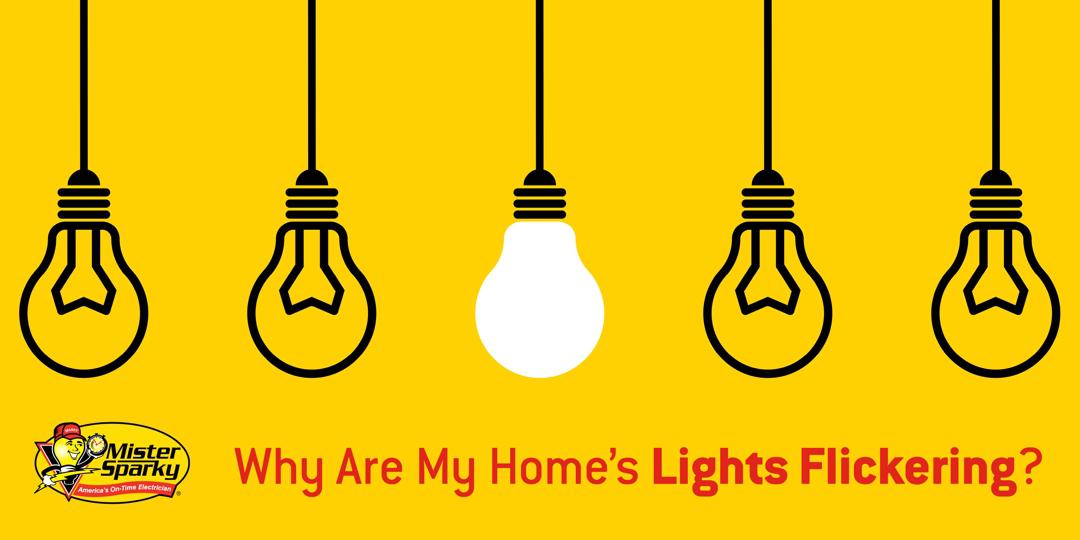Among the most common electrical issues are flickering lights.
Don’t just ignore these little annoyances or start telling ghost stories though! A blinking off and on light can be something minor such as a light bulb that wasn’t properly screwed in or a sign of a more serious issue that requires a professional to safely address it.
Is It Your Light Bulb Type?
Step one: unscrew the light bulb and then put it back in to see if this solves the flickering lights. If it doesn’t, consider that not all light bulbs are created equal. Some types of light bulbs may display light in what is perceived as flickering more than others.
There are many types of light bulbs and light features in every home, but some are more likely to flicker than others:
Incandescent light bulbs: Think of these as “traditional” light bulbs and also think about replacing yours. These light bulbs are inefficient and don’t last as long as other types. The wasted energy of these bulbs is considered a culprit in excessive greenhouse gas emissions.
Compact Fluorescent Lights (CFLs) and other fluorescent bulbs: You know what flickers? Fluorescent lights. When you turn on a fluorescent light, it usually hesitates and then sort of flutters on, sometimes making a small sound too as it warms up. These bulbs are more energy efficient and last longer than traditional light bulbs but do have their drawbacks. Consider this type of bulb for a garage, outdoor lighting, or inside cabinets.
Light-emitting diodes (LED): The winner in energy efficiency is the LED light bulb and unlike fluorescent lights, they can be dimmed. LED lighting can be part of Smart Home planning and also reduce the likelihood of flickering lights from issues with the bulbs.
Halogen light bulbs: Filled with halogen gas instead of inert gas, halogen light bulbs are more energy efficient than incandescent bulbs. These little light bulbs can get pretty hot and are favored for very specific lighting such as track lighting, car headlights, and outdoor floodlights.
When making light bulb changes, be sure to dispose of them properly. Check with your local recycling program about incandescent, halogen, and LED light bulb disposal as these can likely be put in your recycle bin. For fluorescent lights, check Earth911 or ask at your local hardware store about the safest way to dispose of these bulbs that do contain some mercury vapor.
Is Your Light Switch the Culprit?
If after replacing the bulb the flickering lights continue, it’s time to troubleshoot other possible causes of this issue. You may want to consult a professionally-trained electrician for optimum safety and results at this point in your sleuthing.
Light switches don’t last forever and sometimes don’t meet current needs and preferences and require an update. There can be many reasons a light switch no longer works, and it might be a signal that there is a more dangerous issue hidden from your view.
To tell if the problem is coming from the light switch, try these tests:
- Listen closely for a popping or hissing sound coming from the light switch.
- Touch the light switch plate to see if it’s hot.
- Watch for a delay between when the switch is flipped and when the light comes on.
If your light switch exhibits any of these signs, it’s time to call an electrician for help with replacing the switch as safely as possible.
Surging Power and Flickering Lights
While changing a light bulb and even a light switch seem relatively easy solutions to the problem of lights that won’t stay fully on, there can be a much larger problem to consider: power surges.
A power surge is not necessarily the problem, but yet another indicator of an electrical mystery to solve.
Here are some common causes of power surges in the home:
- Lightning strikes nearby
- Electrical overload
- Faulty wiring
- Restoration of power after a blackout period
If there is not a thunderstorm in the area or a recent blackout in your neighborhood, an electrician can come out and determine if there is an electrical overload. Power surges are not uncommon and are only partially preventable due to Mother Nature’s role in causing some of them.
Take steps to possibly prevent a power surge:
- Consider a whole-house surge protector
- Get all wiring up to code
- Avoid plugging large appliances in to the same socket as other appliances
When there are conditions present for an external power surge—such as a blackout—unplug some devices and appliances to reduce the possibility of damage when the power is restored. A sudden power surge can damage devices and appliances so consider the cost of replacing these items versus the cost of hiring a quality electrician to ensure your wiring is up to code and investing in some surge protection before there is a major problem.
You can sometimes tell when there has been a power surge if digital clocks on appliances are blinking or there is a burning smell around outlets.
No More Flickering Lights
Chances are that you need an electrician and not a ghostbuster to solve the issue with your flickering lights.
Contact Mister Sparky today to help solve your flickering lights issues safely.
















